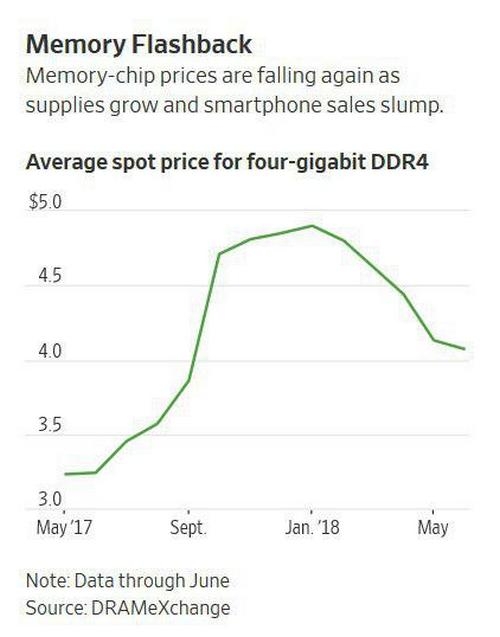Over the past two years, the price of memory chips (DRAM) has constantly increased. The reason for this was primarily a significant increase in demand, because RAM is now used not only in computers or smartphones, but even, for example, in “smart” bulbs that are part of the Internet of things. But, it seems, the situation will change soon, because a number of sources say that memory prices will begin to decline.
For example, the Taiwanese semiconductor manufacturer Nanya Technology believes that in the current quarter, prices for memory chips will reach its maximum and after it start to decline. As President Nanya Lee Pei-Ing noted, prices for some types of RAM chips are already noticeably lower, in particular, for computer DRAM-memory. One would have thought that this was due to the continuing decline in demand for desktops and laptops, but the server segment and data center continued to show steady dynamics, thereby compensating for this drop.
It was also noted that in the current quarter the prices for RAM will stay at about the same level, and fluctuations will be 1-2%. Previously, the head of Nanya made more optimistic forecasts, saying that in the third quarter of 2018, DRAM chips will still be able to gain in price. However, after the investigation of the antimonopoly authorities began regarding Samsung, SK Hynix and Micron, as well as the aggravation of the technological confrontation between the US and China, he changed his point of view.
Note that Nanya Technology is the fourth largest manufacturer of memory chips, after Samsung, SK Hynix and Micron, and in comparison with them occupies a small part of this market. Nevertheless, the company supplies its semiconductor products to such manufacturers as HP, Dell, Kingston, Huawei, Lenovo, Xiaomi and many other electronics manufacturers.
The words of the head of Nanya confirmed and analyst Sean Yang (Sean Yang) from the Shanghai company CINNO. He said that there is currently no rise in prices for RAM. He also predicts that next year the price should decrease due to a decrease in demand for PCs and smartphones. And such promising areas that require quite a lot of DRAM-memory, like artificial intelligence systems and cars with autopilot, can not compensate for this decrease.

Resource The Wall Street Journal gives several other data, which, however, also indicate a decrease in the cost of memory. Referring to DRAMeXchange analysts, the authoritative American resource reports that this year the cost of both operational and solid-state memory dropped by 16% and 37%, respectively.
It is noted that in January of this year the prices for RAM reached a maximum of $ 4.90 for a 4 Gbit DDR4 chip. By June, the price had fallen to $ 4.07. This is due to the decrease in the deficit that was formed earlier. Nevertheless, to date, RAM is more than twice as high as at the beginning of a significant price increase in 2016.
It is also noted that prices for solid-state memory (NAND) are falling faster than on the operational one. During the year, the value fell by more than a third, and will continue to decline, although, perhaps, not so fast.
The reasons for lowering the prices for RAM are the same. The main reason is the decline in smartphone sales and the consequent decrease in demand from their manufacturers. Also, the continuing decline in the desktop and notebook market plays a role. And, finally, increased attention is paid by the regulatory bodies to the main memory producers.
Apparently, in the near future you can really expect a decline in prices for RAM, as well as for solid-state drives. Of course, do not expect that this will happen very soon and instantly, but gradually the prices should come back to normal.